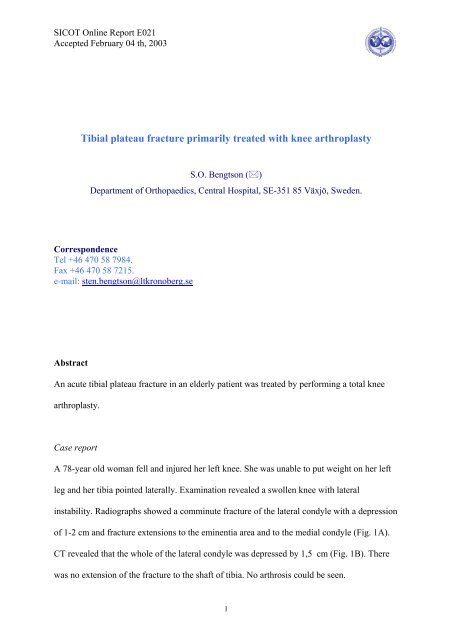Tibial plateau fracture primarily treated with knee arthroplasty - sicot
Tibial plateau fracture primarily treated with knee arthroplasty - sicot
Tibial plateau fracture primarily treated with knee arthroplasty - sicot
You also want an ePaper? Increase the reach of your titles
YUMPU automatically turns print PDFs into web optimized ePapers that Google loves.
SICOT Online Report E021<br />
Accepted February 04 th, 2003<br />
<strong>Tibial</strong> <strong>plateau</strong> <strong>fracture</strong> <strong>primarily</strong> <strong>treated</strong> <strong>with</strong> <strong>knee</strong> <strong>arthroplasty</strong><br />
S.O. Bengtson ()<br />
Department of Orthopaedics, Central Hospital, SE-351 85 Växjö, Sweden.<br />
Correspondence<br />
Tel +46 470 58 7984.<br />
Fax +46 470 58 7215.<br />
e-mail: sten.bengtson@ltkronoberg.se<br />
Abstract<br />
An acute tibial <strong>plateau</strong> <strong>fracture</strong> in an elderly patient was <strong>treated</strong> by performing a total <strong>knee</strong><br />
<strong>arthroplasty</strong>.<br />
Case report<br />
A 78-year old woman fell and injured her left <strong>knee</strong>. She was unable to put weight on her left<br />
leg and her tibia pointed laterally. Examination revealed a swollen <strong>knee</strong> <strong>with</strong> lateral<br />
instability. Radiographs showed a comminute <strong>fracture</strong> of the lateral condyle <strong>with</strong> a depression<br />
of 1-2 cm and <strong>fracture</strong> extensions to the eminentia area and to the medial condyle (Fig. 1A).<br />
CT revealed that the whole of the lateral condyle was depressed by 1,5 cm (Fig. 1B). There<br />
was no extension of the <strong>fracture</strong> to the shaft of tibia. No arthrosis could be seen.<br />
1
SICOT Online Report E021<br />
Accepted February 04 th, 2003<br />
A B<br />
Fig. 1 AP radiograph (A) and CT scan (B) showing a comminute <strong>fracture</strong> of the lateral<br />
condyle <strong>with</strong> extensions to the medial condyle<br />
She was operated upon using a total <strong>knee</strong> prosthesis - AGC (Anatomical Graduated<br />
Components, Biomet Merck). Six weeks postoperatively the patient could walk freely <strong>with</strong>out<br />
a stick and had no pain. The <strong>knee</strong> was stable and had full range of movement.<br />
After one year the result was equally satisfactory. Radiographs showed no loosening of the<br />
prosthesis (Fig. 2).<br />
2
SICOT Online Report E021<br />
Accepted February 04 th, 2003<br />
Fig. 2 Antero-posterior and lateral radiographs one year postoperatively.<br />
Discussion<br />
Normally this patient would have been <strong>treated</strong> <strong>with</strong> open reduction, bone transplantation and<br />
plate fixation. The <strong>knee</strong> would have been immobilized in a plaster-of-Paris for four weeks and<br />
no weight bearing allowed for 3-4 months. Being confined to a wheel chair for that long<br />
might be detrimental to an elderly person. In the long view there is a risk of developing lateral<br />
gonarthrosis necessitating total <strong>knee</strong> prosthesis [5].<br />
So, it was reasoned, why not insert a prosthesis right away, allowing the patient immediate<br />
mobilization and weight bearing. However, no reference was found in the literature of Total<br />
Knee Replacement in the primary treatment of tibial <strong>plateau</strong> <strong>fracture</strong>. Knee <strong>arthroplasty</strong> has<br />
been used after failure of internal fixation of the tibial <strong>plateau</strong> [5]. Treatment by long<br />
3
SICOT Online Report E021<br />
Accepted February 04 th, 2003<br />
stemmed total <strong>knee</strong> replacement has been suggested for <strong>fracture</strong>s of the proximal tibia below<br />
an osteoarthritic <strong>knee</strong> in elderly patients [6]. On the other hand, primary use of prosthesis has<br />
been recommended for dislocated cervikal <strong>fracture</strong>s of the hip [1,4] as well as for<br />
comminuted <strong>fracture</strong>s of the proximal humerus [3] and of the distal humerus [2]. It was only<br />
after discussion <strong>with</strong> and consent of the patient that the <strong>knee</strong> prosthesis was inserted.<br />
The good early result was surprising. It might be that the patient before the accident was fit<br />
and had no <strong>knee</strong> arthrosis, therefore allowing for a more rapid recovery – in contrast to<br />
patients <strong>with</strong> longstanding arthrosis or arthritis <strong>treated</strong> <strong>with</strong> TKR. When using this method it<br />
is important to have at hand tibial prostheses <strong>with</strong> long shafts allowing for better fixation.<br />
Primary use of TKR might be considered an alternative treatment for elderly patients <strong>with</strong><br />
intraarticular <strong>fracture</strong>s of the tibia not extending past the metaphyseal area.<br />
References<br />
1. D'Arcy J, Devas M (1976) Treatment of <strong>fracture</strong>s of the femoral neck by replacement<br />
<strong>with</strong> the Thompson prosthesis. J Bone Joint Surg [Br] 58:279-86.<br />
2. Gambirasio R. Riand N. Stern R. Hoffmeyer P (2001) Total elbow replacement for<br />
complex <strong>fracture</strong>s of the distal humerus. An option for the elderly patient. J Bone Joint Surg<br />
[Br] 83: 974-8.<br />
3. Levine W, Connor P, Yamaguchi K, Self E, Arroyo J, Pollock R, Flatow E, Bigliani L<br />
(1998) Humeral head replacement for proximal humeral <strong>fracture</strong>s. Ortopedics 21: 68-73.<br />
4. Rogmark C, Carlsson Å, Johnell O, Sernbo I (2002) A prospective randomised trial of<br />
internal fixation versus <strong>arthroplasty</strong> for displaced <strong>fracture</strong>s of the neck of the femur. J Bone<br />
Joint Surg [Br] 84: 183-8.<br />
5. Saleh KJ, Sherman P, Katkin P, Windsor R, Haas S, Laskin R,Sculco T (2001) Total<br />
<strong>knee</strong> <strong>arthroplasty</strong> after open reduction and internal fixation of <strong>fracture</strong>s of the tibial <strong>plateau</strong>. J<br />
Bone Joint Surg [Am] 83:1144-48.<br />
6. Wilkes RA, Thomas WG, Ruddle A (1994) Fracture and nonunion of the proximal tibia<br />
below an osteoarthritic <strong>knee</strong>: treatment by long stemmed total <strong>knee</strong> replacement. J Trauma<br />
36:356-7.<br />
4
















